
Insects in the family Tettigoniidae are commonly called katydids or bush crickets. They have previously been known as "long-horned grasshoppers". More than 8,000 species are known. Part of the suborder Ensifera, the Tettigoniidae are the only extant (living) family in the superfamily Tettigonioidea.

Ballus chalybeius is a jumping spider. It is the type species of the genus Ballus.

The northern greater galago, also known as Garnett's greater galago, Garnett's galago, or the small-eared greater galago, is a nocturnal, arboreal primate endemic to Africa.
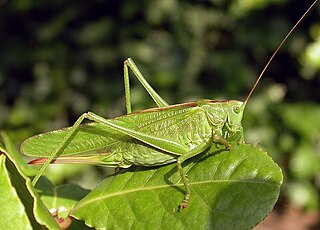
The Tettigoniinae are a subfamily of bush crickets or katydids, which contains hundreds of species in about twelve tribes.
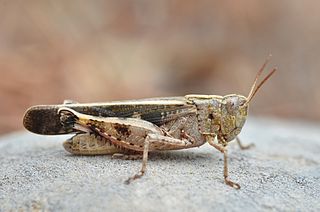
Aiolopus strepens is a species of grasshopper belonging to the family Acrididae, subfamily Oedipodinae.

Tylopsis lilifolia, the lily bush-cricket, is a species of Orthopterans in the subfamily Phaneropterinae. It is found in Europe and Asia.
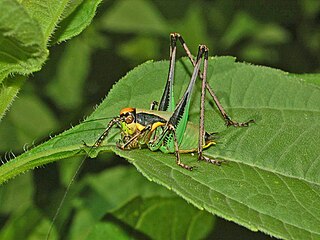
Eupholidoptera chabrieri is a species of katydid belonging to the subfamily Tettigoniinae.

Pholidoptera fallax is a species of 'katydids crickets' belonging to the family Tettigoniidae subfamily Tettigoniinae.
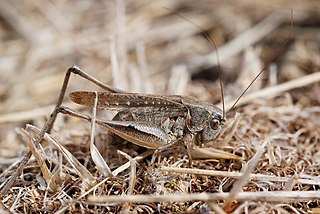
Platycleis is a genus of bush crickets described by Fieber in 1853, belonging to the subfamily Tettigoniinae. The species of this genus are present in Europe, North Africa and temperate Asia.

Yersinella raymondii, common name Raymond's bush-cricket, is a species of "katydids crickets" belonging to the family Tettigoniidae subfamily Tettigoniinae. The scientific name Yersinella comes from the name of the entomologist who has described the species in 1860.

Carrhotus xanthogramma is a species of jumping spider belonging to the family Salticidae.
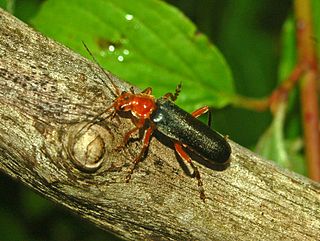
Cantharis livida is a species of soldier beetle belonging to the genus Cantharis and the family Cantharidae.

Barbitistes obtusus, the southern saw-tailed bush-cricket or Alpine saw bush-cricket, is a species of bush crickets in the subfamily Phaneropterinae.

Ephippiger provincialis, the Provence saddle-backed bush cricket, is a species in the family Tettigoniidae.

Leptophyes laticauda is a species of bush-crickets belonging to the family Tettigoniidae.

Platycleis affinis is an insect species belonging to the subfamily Tettigoniinae of family Tettigoniidae. It is found in Southern Europe. Research led by Karim Vahed found that the testes of this bush cricket account for 14% of its total body weight.

Tetrix subulata is the type species of groundhopper in the genus Tetrix, known as the slender ground-hopper, awl-shaped pygmy grasshopper and the slender grouse locust. It is found across the Palearctic: in North America, across much of Europe and Asia, from the British Isles east to Siberia, and to the southern parts of North Africa.
Karim Vahed FRES is a British entomologist. He is a professor of entomology and England manager at invertebrate conservation charity Buglife, and is an expert in crickets and bushcrickets (katydids).

Tachycines asynamorus is a cave cricket and the type species of the genus Tachycines (Rhaphidophoridae). In English-speaking countries it is known as the greenhouse camel cricket or greenhouse stone cricket for its propensity for living in greenhouses. It was first described in 1902 by Russian entomologist Nicolai Adelung on the basis of specimens caught in the palm houses of St. Petersburg. Some authorities have placed this species in the genus Diestrammena, but it has now restored to its basonym.

Zeugma is a small genus of planthoppers from the family Derbidae, tribe Zoraidini, currently (2024) with 9 species. The distribution of the species is restricted to western and central parts of Indonesia, as well as to tropical parts of southern Asia, mainly in and around Malaysia, southern Thailand and southern Cambodia. However, some species are also found in the Philippines, Taiwan and in Assam (India). The species of the genus Zeugma differ from the typical genera in the tribe Zoraidini by a number of unusual features. They lack the long and narrow forewings and the very short hindwings. In addition, the media vein on the forewing has more than 6 branches. These characters are found among genera in the tribe Derbini, to where Zeugma was assigned before the 1950s. The genus was transferred to the Zoraidini by Fennah, mainly based on the venation of the forewings, specifically that of the cubitus and the clavus. Further, when at rest, the live insects do not raise their wings above the body like in most other species of the tribe Zoraidini, but hold them in a roof-like position. Because of these atypical features, the genus Zeugma is placed in a separate subtribe. The colouration of the body is typically straw-coloured to light brown with some parts dark brown, reddish, black or sometimes yellowish. The forewings are translucent, often with brown stripes, especially on or along the veins.





















